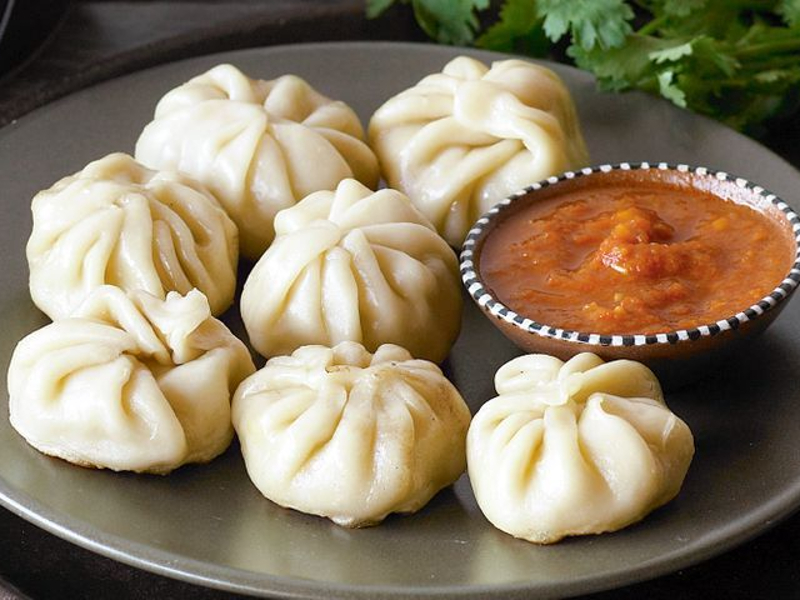info@dreamlandgoldresort.com

- 04 Oct 2023
- By: Dreamland Gold
Momo Nepali Food
MoMo is a type of steamed filled dumpling in Tibetan and Nepali cuisine that is also popular in neighbouring Bhutan and India Momo is usually served with a sauce known as achar influenced by the spices and herbs used within many South Asian cuisines. It can also be cooked as soup versions known as jhol momo where the broth is made from achar using a mixture of tomatoes, sesame seeds, chillies, cumin and coriander or mokthuk from boiling pork/buffalo bones mixed with various herbs and vegetables.

Momo is the colloquial form of the Tibetan word "mog mog". It is possible that this Tibetan word is borrowed from the Chinese term momo, a name traditionally used in northwestern Chinese dialects for wheat steamed buns and bread. The word mo itself means wheat flour food products or mantou, steamed buns. Historically, Chinese names for steamed buns did not distringuish between those with or without fillings until the term baozi emerged during the Song Dynasty between the tenth and thirteenth century. However, in eastern regions of China such as Jiangsu and Shanghai, mantou continues to carry both meanings in modern day. In the Nepal Bhasa language, the word mome (??) means cooking by steaming. The history of momo in Nepal dates back to as early as the fourteenth century.
As for the Himalayan momo, it is not quite known whether it spread from the Kathmandu valley of Nepal to Tibet or the other way around. Because this dish was initially popular among the Newar community of the Kathmandu Valley of Nepal, one prevalent belief is that traveling Nepali Newar merchants took the recipe from Tibet, where they traded, and brought it home to Nepal. Some argue that momo was introduced in Tibet by a Nepalese Newari princess who was married to a Tibetan king in the late fifteenth century, since in Newari, one of Nepal's oldest languages, ‘mome’ means cooking by steaming. In Tibet, the filling of the dish was typically meat, such as yak and occasionally potatoes and cheese. Traditional Tibetan momo is quite different from the Nepalese one as the former was made with a thicker dough and with little to no spices except salt. However, after arriving in the Indo-Gangetic Plains, the meat became chicken, and mixed vegetables momo was introduced to feed the large population of vegetarian Hindus. A large number of Tibetans emigrated to India following the 1959 Tibetan uprising, bringing their recipes for momos with them. Unproven, but substantiated by the dates and references to momo in colloquial references, the civil war in Nepal pushed out the Nepali diaspora to seek a livelihood in India, which further increased the prevalence of Himalayan style momo in the southern half of India especially in the cities of Chennai and Bangalore.

A simple white-flour-and-water dough is generally preferred to make the outer momo covering. Sometimes, a little yeast or baking soda is added to give a more doughy texture to the finished product. Traditionally, momo is prepared with ground/minced meat, potatoes, and leek filling. Nowadays, the fillings have become more elaborate and Momo is prepared with virtually any combination of ground meat, vegetables, tofu, mushrooms, paneer cheese, soft chhurpi (local hard cheese) and vegetable and meat combinations.
-
Meat: Different types of meat fillings are popular in different regions. In Nepal, Tibet, Sikkim, and Bhutan common meat fillings are pork, chicken, goat and water buffalo. In the Himalayan region of Nepal and India, lamb and yak meat are more common. Minced meat is combined with any or all of the following: onions/shallots, garlic, ginger and cilantro/coriander. Some people also add finely puréed tomatoes and soy sauce.
-
Vegetables: Finely chopped cabbage, carrot, soy granules, potato, flat bean (lilva kachori) or chayote (iskush) are used as fillings in Nepal.
-
cheese: Usually fresh Cheese (paneer) or the traditional soft chhurpi is used. This variety is common in Eastern Nepal.
- Khoa: Momo filled with milk solids mixed with sugar are popular as a dessert in the Kathmandu Valley.
The dough is rolled into small circular flat pieces. The filling is enclosed in the circular dough cover either in a round pocket or a half-moon or crescent shape. People prefer meat with a lot of fat because it produces flavourful, juicy momos. A little oil is sometimes added to the lean ground/minced meat to keep the filling moist and juicy. The dumplings are then cooked by steaming over a soup (either a stock based on bones or vegetables) in a momo-making utensil called mucktoo. Momos may also be pan-fried or deep-fried after being steamed.

Momos are traditionally steamed but can also be deep-fried or pan-fried and cooked in soup. It is usually served with chilli garlic sauce and pickled daikon in Tibet. In Nepal, popular dipping sauces include tomato-based chutneys or sesame or peanut or soybean-based sauces called achar. Sauces can be thick or thin in consistency depending on the eatery. Momos may be used in soups, such as jhol momo from Kathmandu, or mokthuk from Tibet.


.jpg)